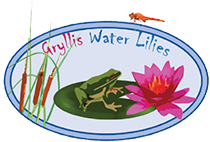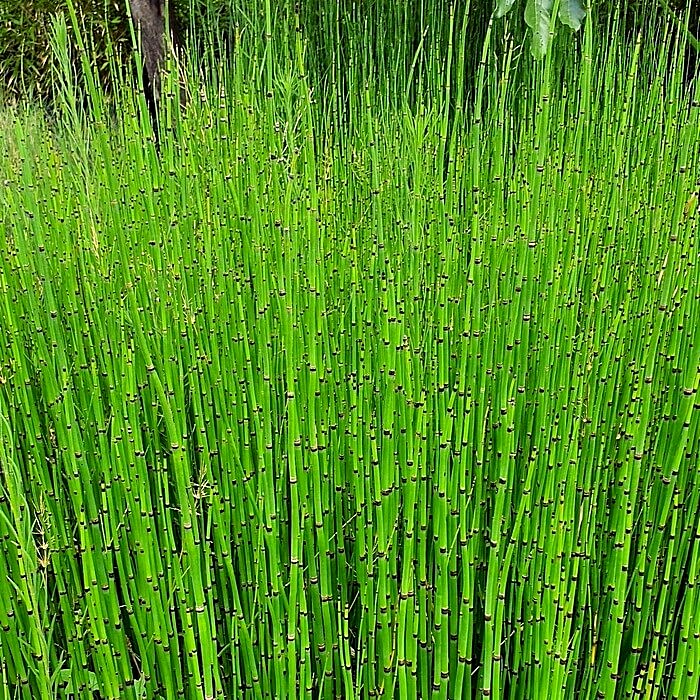| Χαρακτηριστικά | |
| Ύψος | 120cm |
| Πλάτος | 180cm |
| Ανθοφορία | Όχι |
| Χρώμα | Πράσινο |
| Ζώνη καλλιέργειας | 4-5-6-7-8-9-10 |
| Φως | Ήλιος - Ημισκιά |
| Νερό | Μέτριο - Πολύ |
| Ελάχιστη θερμοκρασία | -35°C |
| Έδαφος | Αμμώδες - Πηλώδες - Οργανικό χουμώδες - Βελτιωμένο οργανικό |
Equisetum hyemale
Οικογένεια: Equisetaceae
Περιγραφή
Πρόκειται για πολυετές, ποώδες φυτό με ευρεία εξάπλωση στην Ευρώπη, τη Βόρεια Αμερική και την Ασία, όπου φύεται σε υγρές τοποθεσίες όπως βάλτοι, λεκάνες απορροής, όχθες λιμνών και ποταμών, καθώς και υγρά δασικά ξέφωτα. Το φυτό σχηματίζει πλούσιες, όρθιες συστάδες που εκφύονται από επιφανειακό, κονδυλώδες ρίζωμα, με τα φυτά να έχουν ευμετάβλητες διαστάσεις, φτάνοντας σε ύψος 60 έως 120 cm και πλάτος από 30 έως 180 cm. Κατά το βλαστητικό του στάδιο, το οποίο αρχίζει την άνοιξη και τελειώνει στα τέλη του φθινοπώρου, το φυτό αποτελείται από πολυάριθμα όρθια, σκληρά, γραμμικά, αρκετά παχιά στελέχη έντονου έως σκούρου πράσινου χρώματος, τα οποία φέρουν εσωτερική κοιλότητα και αποτελούνται από μεσογονάτια τμήματα μήκους 5 έως 7 cm. Σε κάθε γόνατο φέρονται μαύρα-καφέ λεπιοειδή φύλλα, τα οποία με τη σειρά τους φέρουν μία ασημόχρωη ζώνη στο κέντρο τους. Το καλοκαίρι, στην άκρη ορισμένων εκ των βλαστών, εμφανίζονται κωνοειδή αναπαραγωγικά όργανα (στρόβιλοι) μήκους 2 έως 3 cm με κίτρινο-καφέ χρώμα, οι οποίοι παράγουν πολυάριθμα μικροσκοπικά σπόρια.
Καλλιέργεια
Είναι φυτό πολύ γρήγορης ανάπτυξης, εξαιρετικά ζωηρό, εύρωστο και εύκολο στην καλλιέργειά του. Συνήθως προτιμάει τις σκιερές θέσεις, ιδιαίτερα σε πιο θερμά και ξηρά κλίματα, όμως προσαρμόζεται και στις πιο ηλιόλουστες όταν το έδαφος είναι υγρό. Όσον αφορά τις εδαφικές συνθήκες, προτιμάει ελαφριά, πλούσια και υγρά εδάφη τα οποία είναι ελαφρώς αλκαλικά, ενώ αναπτύσσεται εξαιρετικά σε ρηχό νερό βάθους 1 έως 10 cm. Είναι ανθεκτικό σε θερμοκρασίες έως - 35 °C, ενώ σημειώνεται πως πρόκειται για ένα από τα αειθαλή είδη του γένους. Όταν φυτεύεται σε θέσεις μακριά από υδάτινα σώματα, θα πρέπει να εξασφαλίζεται η συνεχής διαθεσιμότητα νερού, με τα φυτά να μην είναι ιδιαίτερα ανθεκτικά στην ξηρασία. Πολύ γρήγορα δημιουργεί πλούσιες, πυκνές συστάδες με τη βοήθεια του ριζώματός του, συχνά εμφανίζοντας επεκτατικές τάσεις σε ευνοϊκές συνθήκες. Πρόκειται για φυτό ιδιαίτερα ανθεκτικό σε ασθένειες και εχθρούς, ενώ έχει πρακτικά μηδαμινές ανάγκες περιποίησης και συντήρησης εφόσον εγκατασταθεί σωστά σε θέση με ευνοϊκές συνθήκες. Αντιδρά εξαιρετικά καλά και γρήγορα στην αζωτούχο λίπανση, ενώ απαιτεί πολύ καλό αερισμό των ριζών του. Συνίσταται κατά αραιά διαστήματα να αφαιρούνται όλα τα νεκρά στελέχη,Ο πολλαπλασιασμός γίνεται πολύ εύκολα με διαίρεση του ριζώματος.
Χρήσεις
Το εντυπωσιακό είδος αυτό αποτελεί ένα από τα πιο δημοφιλή καλλωπιστικά μέλη του γένους, με τους αρχιτεκτονικούς, γραμμικούς βλαστούς να το καθιστούν πολύτιμο για κήπους σύγχρονης αισθητικής. Ιδιαίτερα κατάλληλο για ομαδικές φυτεύσεις σε υγρές, σχετικά σκιερές παρόχθιες και παραλίμνιες τοποθεσίες, όπου αναδεικνύεται καλύτερα σε μεγάλες ομαδικές φυτεύσεις που μπορούν να χρησιμεύσουν ως υπόβαθρο για άλλα φυτά, καθώς και ως ασυνήθιστο γλαστρόφυτο σε συχνά αρδευόμενα ή βυθισμένα στο νερό φυτοδοχεία. Πολύ χρήσιμο για τοποθεσίες με ιδιαίτερα κακή στράγγιση, καθώς και για αβαθή τέλματα, στέρνες και σιντριβάνια. Αναφέρονται πολλές χρήσεις του ως φαρμακευτικό φυτό, ενώ έχει χρησιμοποιηθεί επιτυχώς για την αποκατάσταση υποβαθμισμένων υδροβιότοπων.


